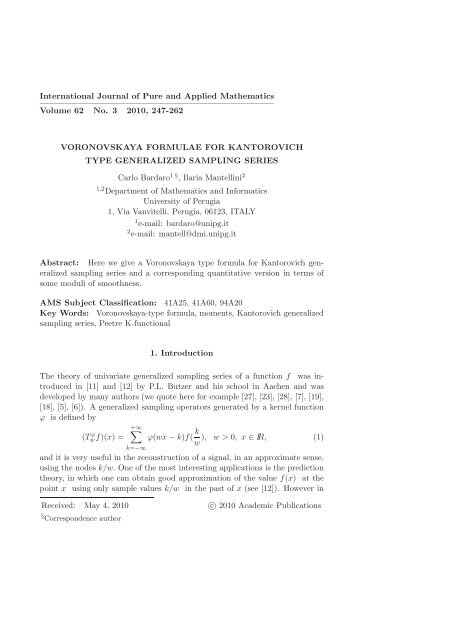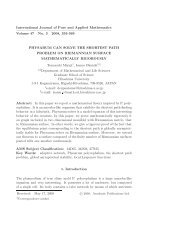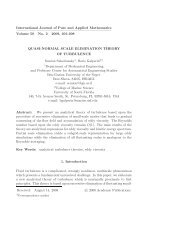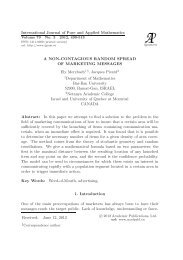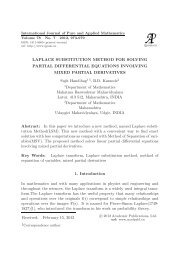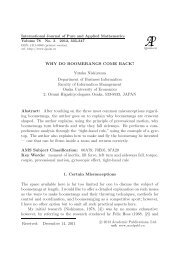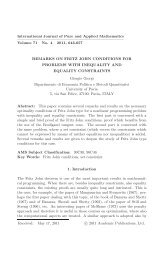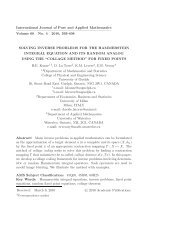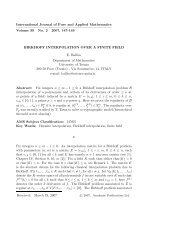VORONOVSKAYA FORMULAE FOR KANTOROVICH TYPE ...
VORONOVSKAYA FORMULAE FOR KANTOROVICH TYPE ...
VORONOVSKAYA FORMULAE FOR KANTOROVICH TYPE ...
You also want an ePaper? Increase the reach of your titles
YUMPU automatically turns print PDFs into web optimized ePapers that Google loves.
International Journal of Pure and Applied Mathematics<br />
————————————————————————–<br />
Volume 62 No. 3 2010, 247-262<br />
<strong>VORONOVSKAYA</strong> <strong><strong>FOR</strong>MULAE</strong> <strong>FOR</strong> <strong>KANTOROVICH</strong><br />
<strong>TYPE</strong> GENERALIZED SAMPLING SERIES<br />
Carlo Bardaro 1 § , Ilaria Mantellini 2<br />
1,2 Department of Mathematics and Informatics<br />
University of Perugia<br />
1, Via Vanvitelli, Perugia, 06123, ITALY<br />
1 e-mail: bardaro@unipg.it<br />
2 e-mail: mantell@dmi.unipg.it<br />
Abstract: Here we give a Voronovskaya type formula for Kantorovich generalized<br />
sampling series and a corresponding quantitative version in terms of<br />
some moduli of smoothness.<br />
AMS Subject Classification: 41A25, 41A60, 94A20<br />
Key Words: Voronovskaya-type formula, moments, Kantorovich generalized<br />
sampling series, Peetre K-functional<br />
1. Introduction<br />
The theory of univariate generalized sampling series of a function f was introduced<br />
in [11] and [12] by P.L. Butzer and his school in Aachen and was<br />
developed by many authors (we quote here for example [27], [23], [28], [7], [19],<br />
[18], [5], [6]). A generalized sampling operators generated by a kernel function<br />
ϕ is defined by<br />
(T ϕ wf)(x) =<br />
+∞<br />
k=−∞<br />
ϕ(wx − k)f( k<br />
), w > 0, x ∈ IR, (1)<br />
w<br />
and it is very useful in the reconstruction of a signal, in an approximate sense,<br />
using the nodes k/w. One of the most interesting applications is the prediction<br />
theory, in which one can obtain good approximation of the value f(x) at the<br />
point x using only sample values k/w in the past of x (see [12]). However in<br />
Received: May 4, 2010 c○ 2010 Academic Publications<br />
§ Correspondence author
248 C. Bardaro, I. Mantellini<br />
some cases one cannot determine the exact value f(k/w) at the node k/w. Thus<br />
it seems to be useful to consider in place of f(k/w) a mean value of f in a<br />
small interval [k/w,(k + 1)/w]. This leads to a new version of the operator (1)<br />
of type<br />
(S ϕ wf)(x) =<br />
+∞<br />
k=−∞<br />
k+1 <br />
ϕ(wx − k) w<br />
w<br />
k<br />
w<br />
f(u)du , w > 0, x ∈ IR. (2)<br />
This operator can be considered as a “Kantorovich” version of the generalized<br />
sampling series (1), taking inspiration in the classical Kantorovich version of<br />
the Bernstein polynomials (see [17], [8], [31], [20], [15]). It was introduced in<br />
[4] where some modular convergence results are obtained in Orlicz spaces (for<br />
a nonlinear version of the results from [4], see [32]).<br />
In [6], using a class of kernels ϕ with null first order (discrete) moment, we<br />
obtained an asymptotic formula of the second order of type<br />
lim<br />
w→+∞ w2 [(T ϕ wf)(x) − f(x)] = Af ′′ (x), (3)<br />
where A is a constant depending on the second order moment of ϕ and the<br />
function f is twice differentiable at the point x.<br />
In this paper using the same class of kernels, we obtain an asymptotic<br />
formula of type<br />
lim<br />
w→+∞ w[(Sϕ 1<br />
wf)(x) − f(x)] =<br />
2 f ′ (x), (4)<br />
where f is only differentiable at the point x. It is interesting to remark here<br />
that the limit in (4) is fully independent of the kernel ϕ. Moreover we notice<br />
that the order of pointwise approximation in (4) cannot be improved also for<br />
more regular functions f.<br />
The second main result is a quantitative version of (4) which shows that<br />
when f belongs to C 1 (IR) the convergence is uniform. As in [6] for the<br />
quantitative version of (3), the main tool is an approach considered in [16]<br />
which is based on the classical K-functional introduced by J. Peetre (see [25]<br />
and [26]) and widely used in various context (see [21], [22], [14], [13], [2] and<br />
[3]).<br />
Finally we give some examples of kernels for which the theory developed<br />
can be applied. In particular we examine the one dimensional Bochner-Riesz<br />
kernel, a Blackman-Harris type kernel, the generalized Jackson kernels and some<br />
combinations of central B-splines. As a final remark note that quantitative<br />
Voronovskaya formulae have important links with the theory of semi-groups<br />
of operators (see [9]). The strict connections between the two theories were
<strong>VORONOVSKAYA</strong> <strong><strong>FOR</strong>MULAE</strong> <strong>FOR</strong> <strong>KANTOROVICH</strong>... 249<br />
described in [1].<br />
2. The Voronovskaya Formula<br />
Let us denote by C 0 = C 0 (IR) the space of all uniformly continuous and<br />
bounded functions f : IR → IR, endowed with the usual supnorm f∞ and<br />
for k ≥ 1 by C k = C k (IR) the subspace of C 0 whose elements f are k-times<br />
continuosly differentiable and f (k) ∞ < +∞.<br />
Let ϕ ∈ C0 be fixed. For any ν ∈ IN0, u ∈ IR let us define the algebraic<br />
moments<br />
and the absolute moments<br />
mν(ϕ,u) :=<br />
Mν(ϕ) := sup<br />
+∞<br />
k=−∞<br />
+∞<br />
u∈IR<br />
k=−∞<br />
ϕ(u − k)(k − u) ν<br />
|ϕ(u − k)||k − u| ν .<br />
Remark. Note that for µ, ν ∈ IN0 with µ < ν, Mν(ϕ) < +∞ implies<br />
Mµ(ϕ) < +∞. Indeed for µ < ν we have<br />
+∞<br />
|ϕ(u − k)||k − u| µ<br />
k=−∞<br />
= <br />
|u−k|r<br />
ϕ(u − k) = 1,<br />
|ϕ(u − k)|(k − u) 2 = 0
250 C. Bardaro, I. Mantellini<br />
uniformly with respect to u ∈ IR,<br />
iii) for every u ∈ IR we have<br />
m1(ϕ,u) ≡ m1(ϕ) =<br />
+∞<br />
k=−∞<br />
ϕ(u − k)(k − u) = 0.<br />
Remark. Note that assumption ii) implies that for j = 0,1, there holds<br />
<br />
lim |ϕ(u − k)||k − u| j = 0<br />
r→+∞<br />
|u−k|>r<br />
uniformly with respect to u ∈ IR. Indeed, for example<br />
<br />
|ϕ(u − k)| < 1<br />
r2 <br />
|ϕ(u − k)|(k − u) 2 .<br />
|u−k|>r<br />
|u−k|>r<br />
For w > 0 and for a kernel ϕ we define a family of operators (S ϕ w)w>0 by<br />
(see [4])<br />
(S ϕ wf)(x) =<br />
+∞<br />
k=−∞<br />
k+1 <br />
ϕ(wx − k) w<br />
w<br />
k<br />
w<br />
f(u)du , x ∈ IR.<br />
Under the above assumptions there holds L ∞ (IR) ⊂ Dom S := <br />
w>0 Dom Sϕ w<br />
where Dom S ϕ w is the space of all functions f : IR → IR for which the series<br />
defining S ϕ wf is absolutely convergent for every x ∈ IR.<br />
We have the following Voronovskaya formula for S ϕ wf.<br />
Theorem 1. Let f ∈ L∞ (IR) be a function such that f ′ (x) exists at a<br />
point x ∈ IR. Under the above assumptions there holds<br />
lim<br />
w→+∞ w[(Sϕ wf)(x) − f(x)] = f ′ (x)<br />
2 .<br />
Proof. We have that<br />
(S ϕ wf)(x) − f(x) =<br />
+∞<br />
k=−∞<br />
<br />
ϕ(wx − k) w<br />
k+1<br />
w<br />
k<br />
w<br />
<br />
(f(u) − f(x))du .<br />
Since f is differentiable at the point x there exists a bounded function h such<br />
that limt→0 h(t) = 0 and<br />
Thus we have<br />
f(u) = f(x) + f ′ (x)(u − x) + h(u − x)(u − x).<br />
(S ϕ w f)(x) − f(x) = f ′ (x)<br />
+∞<br />
k=−∞<br />
<br />
ϕ(wx − k) w<br />
k+1<br />
w<br />
k<br />
w<br />
<br />
(u − x)du
<strong>VORONOVSKAYA</strong> <strong><strong>FOR</strong>MULAE</strong> <strong>FOR</strong> <strong>KANTOROVICH</strong>... 251<br />
+<br />
+∞<br />
k=−∞<br />
We immediately have<br />
k+1<br />
<br />
ϕ(wx − k) w<br />
k<br />
w<br />
w<br />
h(u − x)(u − x)du = I1 + I2.<br />
I1 = f ′ (x)<br />
= f ′ (x)<br />
2<br />
= f ′ (x)<br />
2<br />
− f ′ (x)<br />
2<br />
= f ′ (x)<br />
2w<br />
+∞<br />
k=−∞<br />
+∞<br />
k=−∞<br />
+∞<br />
k=−∞<br />
+∞<br />
k=−∞<br />
+∞<br />
k=−∞<br />
<br />
ϕ(wx − k) w<br />
k+1<br />
w<br />
k<br />
w<br />
<br />
(u − x)du<br />
<br />
ϕ(wx − k)w ( k + 1<br />
w − x)2 − ( k<br />
<br />
− x)2<br />
w<br />
k + 1<br />
ϕ(wx − k)w( − x)2<br />
w<br />
ϕ(wx − k)w( k<br />
− x)2<br />
w<br />
ϕ(wx − k) + f ′ (x)<br />
= f ′ (x)<br />
2w + f ′ (x)<br />
w m1(ϕ) = f ′ (x)<br />
2w .<br />
Now we estimate<br />
I2 =<br />
+∞<br />
k=−∞<br />
+∞<br />
k=−∞<br />
ϕ(wx − k)( k<br />
− x)<br />
w<br />
k+1<br />
<br />
ϕ(wx − k) w<br />
w<br />
k<br />
w<br />
h(u − x)(u − x)du .<br />
In oder to do that let ε > 0 be fixed. There exists η > 0 such that |h(t)| ≤ ε for<br />
every |t| ≤ η.<br />
Moreover let w > 0 such that for every w > w, 1/w < η/2. Then we have<br />
|I2| ≤<br />
<br />
k+1<br />
w<br />
|ϕ(wx − k)|w |h(u − x)||u − x|du<br />
+<br />
<br />
|k−wx|≥ηw/2<br />
= I ′ 2 + I ′′<br />
2.<br />
|k−wx|
252 C. Bardaro, I. Mantellini<br />
we have<br />
≤ ε<br />
2<br />
≤ ε<br />
w<br />
|I ′ 2| ≤ ε <br />
|k−wx| 0 be such that<br />
<br />
|ϕ(u − k)|(u − k) 2 < ε<br />
|u−k|>R<br />
− x)2<br />
uniformly with respect to u ∈ IR. Moreover let w be such that ηw/2 > R, for<br />
every w > w. Then<br />
<br />
|ϕ(wx − k)|(wx − k) 2 < ε<br />
|k−wx|>ηw/2<br />
for every x ∈ IR and w > w. Analogously the same inequality holds also for<br />
the series<br />
<br />
|ϕ(wx − k)||wx − k| j < ε<br />
for j = 0,1. So we have<br />
|I ′′<br />
2 | ≤ h∞<br />
≤ h∞<br />
2<br />
|k−wx|>ηw/2<br />
<br />
|k−wx|≥ηw/2<br />
≤ 5εh∞<br />
2w .<br />
So we obtain the assertion.<br />
<br />
|k−wx|≥ηw/2<br />
|ϕ(wx − k)|w<br />
k+1<br />
w<br />
k<br />
w<br />
|u − x|du<br />
<br />
|ϕ(wx − k)|w ( k + 1<br />
w − x)2 + ( k<br />
<br />
− x)2<br />
w<br />
Remark. We can relax the boundedness assumption on f assuming that<br />
there are two positive constants a,b such that<br />
|f(x)| ≤ a + b|x|, for every x ∈ IR.<br />
At first let us remark that in this instance f ∈ Dom S. Indeed<br />
|(S ϕ wf)(x)| ≤<br />
+∞<br />
k=−∞<br />
|ϕ(wx − k)|w<br />
k+1<br />
w<br />
k<br />
w<br />
|f(u)|du
<strong>VORONOVSKAYA</strong> <strong><strong>FOR</strong>MULAE</strong> <strong>FOR</strong> <strong>KANTOROVICH</strong>... 253<br />
≤<br />
+∞<br />
k=−∞<br />
|ϕ(wx − k)|w<br />
k+1<br />
w<br />
k<br />
w<br />
(a + b|u|)du<br />
≤ M0(ϕ)(a + b<br />
2w + bwx2 + b|x|) + M1(ϕ)(2b|x| + b b<br />
) + M2(ϕ)<br />
w w<br />
and so the series defining S ϕ wf is absolutely convergent for every x ∈ IR. Moreover,<br />
putting for a fixed x0 ∈ IR,<br />
P1(x) = f(x0) + f ′ (x0)(x − x0),<br />
the Taylor polynomial of first order centered at the point x0, by the Taylor<br />
formula we can write<br />
f(x) − P1(x)<br />
= h(x − x0),<br />
(x − x0)<br />
where h is a function such that limt→0 h(t) = 0. Then h is bounded in a<br />
neighbourhood of x0, say [x0 − δ,x0 + δ], while for |x − x0| > δ, we have<br />
a + b|x| |P1(x)|<br />
|h(x − x0)| ≤ +<br />
|x − x0| |x − x0| ,<br />
and the second right-hand side of the above inequality is bounded for |x−x0| ><br />
δ. Thus h(· − x0) is bounded on IR, and we can proceed as in the proof of<br />
Theorem 1, obtaining the same Voronovskaya formula.<br />
3. A Quantitative Estimate<br />
Our aim is to determine the order of the convergence in Theorem 1 using a<br />
suitable modulus of continuity.<br />
For a given ε > 0 we define<br />
ω(f,ε) := sup |f(x) − f(y)|.<br />
|x−y|
254 C. Bardaro, I. Mantellini<br />
for x → x0.<br />
In what follows, we will need the following K-functional, introduced by J.<br />
Peetre ([25], see also [26]) and defined by<br />
K(ε,f,C 0 ,C 1 ) := inf{f − g∞ + εg ′ ∞ : g ∈ C 1 }<br />
for f ∈ C 0 and ε ≥ 0. In order to relate the K-functional to a modulus of<br />
continuity, we will quote the following lemma (see [26] Corollary 2.1 and [24]<br />
Lemma 12.1)<br />
Lemma 1. For every f ∈ C0 there holds<br />
K(ε/2,f,C 0 ,C 1 ) = 1<br />
ω(f,ε), ε ≥ 0.<br />
2<br />
Here ω(f, ·) denotes the least concave majorant of ω(f, ·) (see e.g. [3]).<br />
As in [16], we have the following estimate of the remainder Rm(f;x0,x) in<br />
terms of ω<br />
Lemma 2. For m ∈ IN0 let f ∈ Cm and x,x0 ∈ IR. Then we have<br />
<br />
|x − x0| m<br />
|Rm(f;x0,x)| ≤ ω f<br />
m!<br />
(m) <br />
|x − x0|<br />
, .<br />
m + 1<br />
We study an estimate of the convergence in Theorem 1 in terms of the<br />
modulus ω, in case m = 1. We have the following<br />
Theorem 2. Let f ∈ C1 be fixed and let x ∈ IR. Then there holds<br />
|w[(S ϕ wf)(x) − f(x)] − f ′ (x) A<br />
| ≤<br />
2 2 ω<br />
<br />
f ′ , 1<br />
<br />
B<br />
,<br />
w A<br />
where A = M0(ϕ) + M1(ϕ) + 2M2(ϕ) and B = M0(ϕ)/3 + M1(ϕ) + M2(ϕ).<br />
Proof. For a given f ∈ C1 , as in Theorem 1, we can write<br />
<br />
<br />
<br />
(Sϕ wf)(x) − f(x) − f ′ <br />
(x) <br />
<br />
2w <br />
<br />
+∞<br />
= <br />
ϕ(wx − k)f ′ k+1<br />
w<br />
(x)w (u − x)du<br />
+<br />
≤<br />
k=−∞<br />
+∞<br />
ϕ(wx − k)w<br />
k+1<br />
w<br />
k<br />
w<br />
k<br />
w<br />
h(u − x)(u − x)du − f ′ (x)<br />
2w<br />
k=−∞<br />
+∞<br />
k+1<br />
w<br />
|ϕ(wx − k)|w |h(u − x)||u − x|du.<br />
k<br />
k=−∞<br />
w<br />
Putting R1(f,x,u) = h(u−x)(u−x), by Lemma 1 and Lemma 2 for m = 1, we
<strong>VORONOVSKAYA</strong> <strong><strong>FOR</strong>MULAE</strong> <strong>FOR</strong> <strong>KANTOROVICH</strong>... 255<br />
have <br />
<br />
(S ϕ wf)(x) − f(x) − f ′ <br />
(x) <br />
<br />
2w <br />
≤<br />
= 2<br />
<br />
f ′ ,<br />
+∞<br />
k+1<br />
w<br />
|ϕ(wx − k)|w |u − x|ω<br />
k<br />
k=−∞<br />
w<br />
+∞<br />
k+1<br />
w<br />
|ϕ(wx − k)|w |u − x|K<br />
k<br />
k=−∞<br />
w<br />
Let now g ∈ C 2 . We have<br />
J ≤ 2<br />
+∞<br />
k=−∞<br />
= 2(f − g) ′ ∞w<br />
+ g′′ ∞<br />
2 w<br />
+∞<br />
≤ w(f − g) ′ ∞<br />
+ w(f − g) ′ ∞<br />
+ g′′ ∞<br />
6 w<br />
|ϕ(wx − k)|w<br />
+∞<br />
k=−∞<br />
k=−∞<br />
+∞<br />
+∞<br />
k=−∞<br />
≤ A (f − g)′ ∞<br />
w<br />
|ϕ(wx − k)|<br />
k=−∞<br />
+∞<br />
k=−∞<br />
k+1<br />
w<br />
k<br />
w<br />
|ϕ(wx − k)|<br />
k+1<br />
w<br />
k<br />
w<br />
<br />
|x − u|<br />
du<br />
2<br />
|u − x|<br />
4<br />
<br />
|u − x| (f − g) ′ ∞ +<br />
k+1<br />
w<br />
k<br />
w<br />
(u − x) 2 du<br />
|u − x|du<br />
k + 1<br />
|ϕ(wx − k)|( − x)2<br />
w<br />
|ϕ(wx − k)|( k<br />
− x)2<br />
w<br />
,f ′ ,C 0 ,C 1<br />
<br />
du := J.<br />
<br />
3 k<br />
− x) + ( − x)2<br />
w w<br />
<br />
1 3 k<br />
|ϕ(wx − k)| +<br />
w3 w2( w<br />
+ B g′′ <br />
∞ A<br />
= (f − g)<br />
2w2 w<br />
′ ∞ + g′′ <br />
∞ B<br />
.<br />
2w A<br />
Taking the infimum over g ∈ C 2 we obtain<br />
and so the assertion follows.<br />
J ≤ A<br />
2w ω<br />
<br />
f ′ , 1<br />
w<br />
<br />
B<br />
A<br />
|x − u|<br />
g<br />
4<br />
′′ <br />
∞ du<br />
Remark. As a consequence of Theorem 2, under the above assumptions<br />
we get the uniform convergence for w((S ϕ wf)(x) − f(x)) to f′ (x)<br />
2 .<br />
Remark. Note that when ϕ has a compact support I = [−R,R], R > 0 we<br />
can obtain a slightly different estimate
256 C. Bardaro, I. Mantellini<br />
<br />
<br />
<br />
w[(Sϕ wf)(x) − f(x)] − f ′ <br />
(x) <br />
<br />
2 <br />
Indeed we have easily<br />
J ≤ A (f − g)′ ∞<br />
w<br />
≤ M0(ϕ)(1 + R + 2R2 )<br />
ω<br />
2<br />
<br />
f ′ , 1<br />
w<br />
1/3 + R + R2 1 + R + 2R2 <br />
.<br />
+ B g′′ ∞<br />
2w2 ≤ M0(ϕ)(1 + R + 2R 2 ) (f − g)′ ∞<br />
w<br />
4. Examples<br />
+ M0(ϕ)(1/3 + R + R 2 ) g′′ ∞<br />
.<br />
2w2 In this section we will consider some particular examples of kernels ϕ for which<br />
the theory developed before can be applied. Note that the Voronovskaya formula<br />
stated in Theorem 1 doesn’t depend on the kernel ϕ and the order of<br />
pointwise approximation to a differentiable function is always the same and it<br />
cannot be improved also when the function f is more regular.<br />
I) The Bochner-Riesz Kernel. Let us consider the one-dimensional<br />
Bochner-Riesz kernel defined by (see e.g. [10] and [30])<br />
ϕ(x) ≡ b γ (x) = 2 γ Γ(γ + 1)(|x|) −1/2−γ J (1/2)+γ(|x|)<br />
for γ > 0, where Jλ is the Bessel function of order λ. It is well known that<br />
b γ <br />
(1 − v2 ) γ , |v| ≤ 1,<br />
(v) =<br />
0, |v| > 1.<br />
Using the Poisson summation formula<br />
(−i) j<br />
+∞<br />
k=−∞<br />
there holds for u ∈ IR<br />
and<br />
ϕ(u − k)(u − k) j ∼<br />
+∞<br />
k=−∞<br />
m1(b γ ) =<br />
+∞<br />
k=−∞<br />
b γ (u − k) = b γ (0) = 1<br />
+∞<br />
k=−∞<br />
ϕ (j) (2πk)e i2πku ,<br />
b γ (u − k)(u − k) = 0.
<strong>VORONOVSKAYA</strong> <strong><strong>FOR</strong>MULAE</strong> <strong>FOR</strong> <strong>KANTOROVICH</strong>... 257<br />
From Proposition 1 in [6], for every γ > 5/2 we have M2(bγ ) < +∞ and<br />
<br />
lim |b γ (u − k)|(u − k) 2 = 0,<br />
r→+∞<br />
|k−u|>r<br />
uniformly with respect to u ∈ IR. Thus all the assumptions are satisfied for this<br />
kernel.<br />
II) A Particular Blackman-Harris Kernel. Let us define the kernel,<br />
for x ∈ IR<br />
ϕ(x) ≡ B(x)<br />
= 1 9<br />
1<br />
sinc(x) + (sinc(x + 1) + sinc(x − 1)) − (sinc(x + 3) + sinc(x − 3)),<br />
2 32 32<br />
where sinc(x) := sinπx<br />
πx . From [18], there holds that B(x) = O(|x|−5 ) as<br />
|x| → +∞. Hence from Remark 3.2(d) and Lemma 3.1 in [4] it follows that<br />
M2(B) is finite and<br />
<br />
lim |B(u − k)|(u − k) 2 = 0.<br />
|k−u|>r<br />
r→+∞<br />
|k−u|>r<br />
Indeed, there exists N > 0 such that |B(x)| < M/|x| 5 for |x| > N. So,<br />
denoting by [t] the greatest integer less or equal to t, we have for r > N<br />
<br />
|B(u − k)|(u − k) 2 ≤ M 1 M<br />
≤<br />
|u − k| 3 r<br />
1<br />
[u − k] 2<br />
where<br />
Moreover<br />
|k−u|>r<br />
B(v) = 1<br />
√ 2π λ( v<br />
π ),<br />
|k−u|>r<br />
≤ 2M<br />
r<br />
∞<br />
k=1<br />
1<br />
k 2.<br />
λ(v) = ( 1 9 1<br />
+ cos(πv) −<br />
2 16 16 cos(3πv))χ [−1,1](v)<br />
and χI denotes the characteristic function of the set I. Thus using Lemma 3<br />
in [12] we have<br />
m1(B) =<br />
+∞<br />
k=−∞<br />
B(u − k)(u − k) = 0.<br />
Thus all the assumptions are satisfied for this kernel.<br />
III) The Generalized Jackson Kernels. For every n ∈ IN let us
258 C. Bardaro, I. Mantellini<br />
consider the function (see [4])<br />
ϕ(x) ≡ Gn(x) = cnsinc 2n ( x<br />
),<br />
2nπα<br />
x ∈ IR<br />
where α ≥ 1 and cn is a normalization constant. For n ≥ 2 from Remark<br />
3.2(d) and Lemma 3.1 in [4] it follows that M2(Gn) is finite and as in the<br />
previous example we have<br />
lim<br />
<br />
|Gn(u − k)|(u − k) 2 = 0.<br />
r→+∞<br />
|k−u|>r<br />
Moreover taking into account that Gn is bandlimited to the interval [−1/α,1/α]<br />
and using again the Poisson summation formula we get<br />
m1(Gn) =<br />
+∞<br />
k=−∞<br />
Gn(u − k)(u − k) = 0.<br />
Thus all the assumptions are satisfied for this kernel.<br />
IV) Combinations of Spline Functions. Here, using a method developed<br />
in [12], we give an explicit example of kernel ϕ with compact support,<br />
satisfying all the previous assumptions. In order to do that, let us define the<br />
central B-splines of order h ∈ IN as<br />
h 1<br />
Bh(x) := (−1)<br />
(h − 1)!<br />
j<br />
<br />
h<br />
j<br />
j=0<br />
<br />
( h<br />
+ x − j)h−1 +<br />
2 ,<br />
where xr + := max{xr ,0}. It is well known that the Fourier transform of the<br />
functions Bh is given by<br />
h Bh(v)<br />
sin v/2<br />
= , v ∈ IR, h ∈ IN<br />
v/2<br />
(see [29] and [12]). Given real numbers ε0, ε1 with ε0 < ε1 we will construct<br />
a linear combination of translates of Bh, with h ≥ 2, of type<br />
ϕ(x) = a0Bh(x − ε0) + a1Bh(x − ε1)<br />
in such a way that i) and iii) are satisfied (note that in this instance assumption<br />
ii) is automatically satisfied). Using the Poisson summation formula, we have<br />
to find the constants a0 and a1 such that<br />
ϕ(2πk) =<br />
1 k = 0,<br />
0 k = 0,<br />
ϕ ′<br />
(2πk) = 0 for every k ∈ Z.<br />
The Fourier transform of ϕ is given by<br />
ϕ(v) = Bh(v)(a0e −iε0v + a1e −iε1v ).
<strong>VORONOVSKAYA</strong> <strong><strong>FOR</strong>MULAE</strong> <strong>FOR</strong> <strong>KANTOROVICH</strong>... 259<br />
Since<br />
we obtain the system<br />
and<br />
B ′ h (2kπ) = 0 for every k ∈ Z<br />
ϕ(0) = a0 + a1 = 1<br />
ϕ ′<br />
(0) = −i(ε0a0 + ε1a1) = 0<br />
while for k = 0 we obtain identities 0 = 0. Solving the above linear system we<br />
obtain the unique solution<br />
a0 = ε1<br />
, a1 = −<br />
ε1 − ε0<br />
ε0<br />
.<br />
ε0 − ε1<br />
Moreover it is easy to see that the support of the function ϕ is contained<br />
in the interval [ε0 − h<br />
2 ,ε1 + h<br />
2 ].<br />
References<br />
[1] F. Altomare, Limit semigroups of Bernstein-Schnabl operators associated<br />
with positive projection, Ann. Sc. Norm. Super. Pisa Cl. Sci., Ser. IV, 16<br />
(1989), 259-279.<br />
[2] F. Altomare, M. Campiti, Korovkin-Type Approximation Theory, its Applications,<br />
Walter de Gruyter, Berlin, New York (1994).<br />
[3] G.A. Anastassiou, S.G. Gal, Approximation Theory. Moduli of Continuity<br />
and Global Smoothness Preservation, Birkhäuser, Boston (2000).<br />
[4] C. Bardaro, P.L. Butzer, R.L. Stens, G. Vinti, Kantorovich-type generalized,<br />
sampling series in the setting of Orlicz spaces, Sampling Theory in<br />
Signal and Image Processing, 6, No. 1 (2007), 29-52.<br />
[5] C. Bardaro, I. Mantellini, A Voronovskaya type theorem for a general class<br />
of discrete operators, Rocky Mountain J. Math., 39, No. 5 (2009), 1411-<br />
1442.<br />
[6] C. Bardaro, I. Mantellini, A quantitative Voronovskaja formula for generalized<br />
sampling operators, East Journal on Approximation, 15, No. 4<br />
(2009), 429-441.<br />
[7] C. Bardaro, G. Vinti, An abstarct approach to sampling type operators<br />
inspired by the work of P.L. Butzer. Part I-Linear operators, Sampling<br />
Theory in Signal and Image Processing, 2, No. 3 (2003), 271-296.
260 C. Bardaro, I. Mantellini<br />
[8] R. Bojanic, O. Shisha, Degree of L 1 approximation to integrable functions<br />
by modified Bernstein polynomials, J. Approx. Theory, 13 (1975), 66-72.<br />
[9] P.L. Butzer, H. Berens, Semi-groups of operators and approximation, Die<br />
Grundlehren der mathematischen Wissenschaften, 145, Springer-Verlag,<br />
Berlin-Heidelberg-New York (1967).<br />
[10] P.L. Butzer, R. Nessel, Analysis and Approximation I, Academic Press,<br />
New York-London (1971).<br />
[11] P.L. Butzer, R.L. Stens, Sampling theory for not necessarily bandlimited<br />
functions: an historical overview, SIAM Review, 34 (1992), 40-53.<br />
[12] P.L. Butzer, R.L. Stens, Linear prediction by samples from the past, In:<br />
Advanced Topics in Shannon Sampling and Interpolation Theory (Ed. R.J.<br />
Marks II) Springer Texts Electrical Eng., 157-183, Springer, New York<br />
(1993).<br />
[13] Z. Ditzian, Rate of approximation, smoothness and K-functionals, In:<br />
Proc. Int. Conf. Functional Analysis Approximation Theory, Maratea,<br />
September 14-19 (1992); Suppl. Rend. Circolo Mat. Palermo, II, 33 (1993),<br />
63-74.<br />
[14] Z. Ditzian, V. Totik, Moduli of Smoothness, Springer Series in Computational<br />
Mathematics, 9, Springer-Verlag, New York (1987).<br />
[15] Z. Ditzian, X. Zhou, Kantorovich-Bernstein polynomials, Constr. Approx.,<br />
6 (1990), 421-435.<br />
[16] H. Gonska, P. Pitul, I. Rasa, On Peano’s form of the Taylor remainder,<br />
Voronovskaja’s Theorem and the commutator of positive linear operators,<br />
In: Proc. Int. Conf. on Numerical Analysis and Approximation Theory,<br />
Cluj-Napoca, Romania, July 5-8 (2006), 55-80.<br />
[17] L.V. Kantorovich, Sur certains developpements suivant les polynomes de<br />
la forme de S. Bernstein I, II, C.R.Acad. Sci. USSR, 20 (1930), 563-568,<br />
595-600.<br />
[18] A. Kivinukk, G. Tamberg, Shannon sampling series with averaged kernels,<br />
In: Proc. SAMPTA 2007, Thessaloniki, Greece, June 1-5 (2007), 76-85.<br />
[19] A. Kivinukk, G. Tamberg, Interpolating generalized Shannon sampling<br />
operators, their norms and approximation properties, Sampling Theory in<br />
Signal and Image Processing, 8 (2009), 77-95.
<strong>VORONOVSKAYA</strong> <strong><strong>FOR</strong>MULAE</strong> <strong>FOR</strong> <strong>KANTOROVICH</strong>... 261<br />
[20] G.G. Lorentz, Bernstein Polynomials, Chelsea Publ. Co., New York (1986).<br />
[21] L. Maligranda, The K-functional for symmetric spaces, Lecture Notes in<br />
Math., 1070 (1984), 169-182.<br />
[22] L. Maligranda, Interpolation spaces in the theory of approximation. In:<br />
Methods of Functional Analysis in Approximation Theory, Proc. Int. Conf.<br />
Bombay, Dec. 16-20 (1985), ISNM 76, Birkhäuser (1986), 263-279.<br />
[23] I. Mantellini, Generalized sampling operators in modular spaces, Comment.<br />
Math., 38 (1998), 77-92.<br />
[24] B.S. Mitjagin, E.M. Semenov, Lack of interpolation of linear operators in<br />
spaces of smooth functions, Math. USSR-Izv., 11, No. 6 (1977), 1229-1266.<br />
[25] J. Peetre, A Theory of Interpolation of Normed Spaces, Lecture Notes,<br />
Brasilia (1963) (Notas de Matematica, 39, 1968).<br />
[26] J. Peetre, Exact interpolation theorems for Lipschitz continuous functions,<br />
Ricerche Mat., 18 (1969), 239-259.<br />
[27] S. Ries, R.L. Stens, Approximation by generalized sampling series, In:<br />
Constructive Theory of Functions (Ed-s: Bl. Sendov, P. Petrushev, R.<br />
Maalev, S. Tashev), Publ. House Bulgarian Academy of Sciences, Sofia<br />
(1984), 746-756.<br />
[28] H-J. Schmeisser, W. Sickel, Sampling theory and function spaces, In: Applied<br />
Mathematics Reviews, 1, Word Scientific, Singapore (2000), 205-284.<br />
[29] I.J. Schonberg, Cardinal Spline Interpolation, Regional Conference Series<br />
in Applied Mathematics, SIAM, Philadelphia (1973).<br />
[30] E.M. Stein, G. Weiss, Introduction to Fourier Analysis on Euclidean Space,<br />
Princeton University Press, Princeton, NJ (1971).<br />
[31] V. Totik, Approximation in L1 by Kantorovich polynomials, Acta Sci.<br />
Math. (Szeged), 46 (1983), 211-222.<br />
[32] G. Vinti, L. Zampogni, Approximation by means of nonlinear Kantorovich<br />
sampling type operators in Orlicz spaces, J. Approx. Theory, 161 (2009),<br />
511-528.
262 C. Bardaro, I. Mantellini<br />
[33] E.V. Voronovskaya, Determination of the asymptotic form of approximation<br />
of functions by the polynomials of S.N. Bernstein, Dokl. Akad. Nauk<br />
SSSR, A (1932), 79-85.


